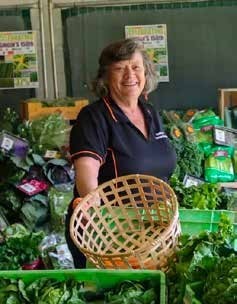discuss
Pricing – how should it be set?
While those who remember lament the end of the auction system, others won’t speak out about the majors, some are frustrated and others have nailed it – how do we win at produce pricing?
Lucy Gregg
AUSVEG national public affairs manager
EVERYONE has an opinion on the price of vegetables, and it is little wonder. Hort Innovation’s Horticulture Statistics Handbook states 99 per cent of Australian households bought fresh vegetables in the previous 12 months, and a recent KPMG report highlighted price as consumers’ number one barrier to buying vegetables. Major retailers promote relationships with producers, filming ads on farms and showcasing fresh produce during primetime shows and events. Fresh produce is often promoted as ‘On Special’ (not ‘In Season’), and reducing the price tag is a drawcard to get consumers in store – this poses some important questions:
• If we continue to lower the value of fresh produce, what impact does this have for growers?
• How can fresh produce continue to be ‘On Special’ if growers are dealing with the most significant cost of production increases in the world?
• What role do retailers play in setting the value perception of fresh produce? And how accountable are they if consumers don’t value fresh produce?
Just because most vegetables are grown outside, it doesn’t mean they are dirt cheap to grow. And they certainly don’t need to be dirt cheap to be great value. Our industry is facing significant challenges, including extreme weather events, biosecurity incursions, severe workforce shortages and price increases for farm inputs.

“ A recent survey ... highlights that Australian growers have experienced some of the highest increases in costs of production in the world… ”
Our labour and input costs have been at the top of the global scale for a long time. A recent survey from the Global Coalition of Fresh Produce highlights that Australian growers have experienced some of the highest increases in costs of production in the world, with on average 37 per cent increases in production and operating costs. This includes:
• More than 100 per cent increases in the costs of fertiliser, and more than 50 per cent increases in fuel and energy (56 per cent), building costs (55 per cent) and packaging costs (57 per cent).
Vegetable prices have remained relatively stable over the past two years despite this, meaning growers have been forced to shoulder the burden of cost of production increases.
Growers have been forced to grow and sell fresh produce at cost (or below), so Australians have access to cheap vegetables (or so retailers can sell cheap vegetables without losing their margins). While growers take great pride in feeding the nation, they are not charities. And, furthermore, the latest financial reports for the big retailers certainly prove that they are not providing food for Australians solely for altruistic reasons, with record profits being reported.
The past three years have been the most stressful and uncertain we’ve ever experienced, and the toll is showing. AUSVEG recently conducted a sentiment survey of its members, which revealed record-low morale among vegetable growers. Labour shortages, policy changes and rising operational factors are forcing these growers to contemplate leaving the industry, with more than 30 per cent now considering leaving the industry within the next 12 months.
If even close to 30 per cent of growers cease vegetable production, frequent fresh produce shortages will become the new norm and families will bear the brunt with higher prices for produce.
If that comes to pass, the impact on our food security will be significant, and the temporary price spikes and empty shelves seen following severe weather in recent years are likely to become the norm. Growers need a fair price for their produce to keep supplying high-quality vegetables to Australian families. We need better informed discussions about cost, price and the responsibility of retailers.
Paul Omodei

Planfarm horticulture director
LET’S acknowledge a truth: pricing is a delicate matter due to the limited influence growers have in today’s marketplace framework. Our clients are frustrated. They’re facing unsustainable pricing offers and are feeling compelled to accept whatever is presented to them. They’re competing against each other in a constrained market, which can make collective efforts challenging. Collaborative work, however, empowers our industry to showcase the average expenses involved in cultivating and processing a unit of produce. These industry-wide statistics serve as a foundation for individual grower negotiations on pricing.
Supermarkets, market agents and direct customer engagement all play distinct roles in bringing produce to consumers’ hands – and mouths. Costs associated with these distribution channels are absorbed by the product as marketing expenses. Growers must carefully evaluate the appeal of each channel, considering the terms that align with their objectives for moving their produce.
The decisive authority rests with the grower who comprehends their figures. While it’s tempting to compare prices achieved by individual growers, this must also consider marketing costs and operational efficiency to be meaningful. Some growers may not secure top market prices, but due to efficient business operations, they yield healthy profits. Beyond price, contractual terms, such as expedited payments, recurring contracts and broader quality allowances, hold value.
We suggest growers delve into operational efficiency. This metric gauges the cost incurred to generate $1 of revenue. A business with a 70 per cent operational efficiency is better positioned to weather adverse pricing fluctuations compared to one with 80 per cent. It’s important to understand business performance metrics to realise improved financial outcomes in your business.
Planfarm is running our Building Horticulture Business Capacity Program. See more on p22.
Maureen Dobra

Loose Leaf Lettuce Company director
WE’VE set our own prices for the past 36 years. When announcing a price increase, we might lose some sales, but when the quality is good, people come back. We have also found that relationships (with agents, competitors, retailers and wholesalers), transparency, consistency and sticking to your guns are key when setting your own prices. It also helps that we grow gourmet lines, not commodities (such as potatoes, onions, carrots, broccoli, cabbages).
When trading with the market, it’s essential to follow the Horticulture Code of Conduct. It states that the terms of trade with your market, or even other wholesalers, needs to be documented. You must register as an agent or a merchant, and document your delivery process, payment terms, commissions and other fees and costs, and what happens to rejected produce, etc.
If you leave your produce at the market to be sold, the market agent will try to get the best price for you and will take a commission from it when it’s sold. If it’s not sold, they may dispose of it or they might sell it at a really cheap price. That’s where growers have problems. However, that can’t happen to us. We’re registered as a merchant and we have an agreement with our market agent and with the wholesalers that we determine: the price we want, when we deliver and when we want to be paid. If there are any rejections, we pick them up and dispose of them. It means we are in control of what we’re doing.
Recently the Federal Government announced a 5.75 per cent wage rise. At the same time, we had a 0.5 per cent increase in superannuation and increases in workers’ compensation insurance and payroll tax. So, we did an analysis of our products over the past 12 months and our expenses. We found these increases in wages would impact us. So, we went through our produce lines (we have about 20) and looked at how much each was costing us to grow, process, bag and deliver/transport. We placed a bigger price increase on the items that took the most labour and a smaller increase on those that didn’t take as much labour. We also looked at our smaller items – products for which we’re only washing 10kg a day – and decided to only do those smaller lines three times a week. We then looked at the cost of how long and how many people it takes to wash and bag those lines. Those that took the longest and most staff increased more than the other lines. We didn’t raise the price of some of the other lines because we felt that consumers were not buying as many.
“ If you don’t have a belief in your produce and don’t run your business to make money, what are you in business for? ”
In terms of changing our pricing, sometimes there was no increase, sometimes there was a little bit and sometimes there was a bit more. Predominantly, it was to cover the cost of the wage increases and other costs associated with wages. We didn’t request this increase. We knew it was required for our business’ viability and we had the figures to back it up. We sent a letter that stated: from this day, these will be the prices of the products you are selling. Some buyers said, ‘fair enough’ and others said ‘no’.
Buyers wanting our produce needed to buy it at our new prices. It’s about having a belief in your produce, and steering your business to be viable. If you don’t have a belief in your produce and don’t run your business to make money, what are you in business for?
It’s important to sit down and do your sums. Whether you’re a grower the size of us, a small grower or a larger one who’s got the capacity and the staff to do it for you, you need to do your sums. If you’re selling for $4 and your expenses are $6, you’re going backwards. That’s not running a business. What has opened our eyes for me and my family is doing the BHBC program (see p22) with Bryn and Paul. It does take up time and I know people have busy schedules, but if you don’t take that time, then you don’t know if you’re running a business or not.